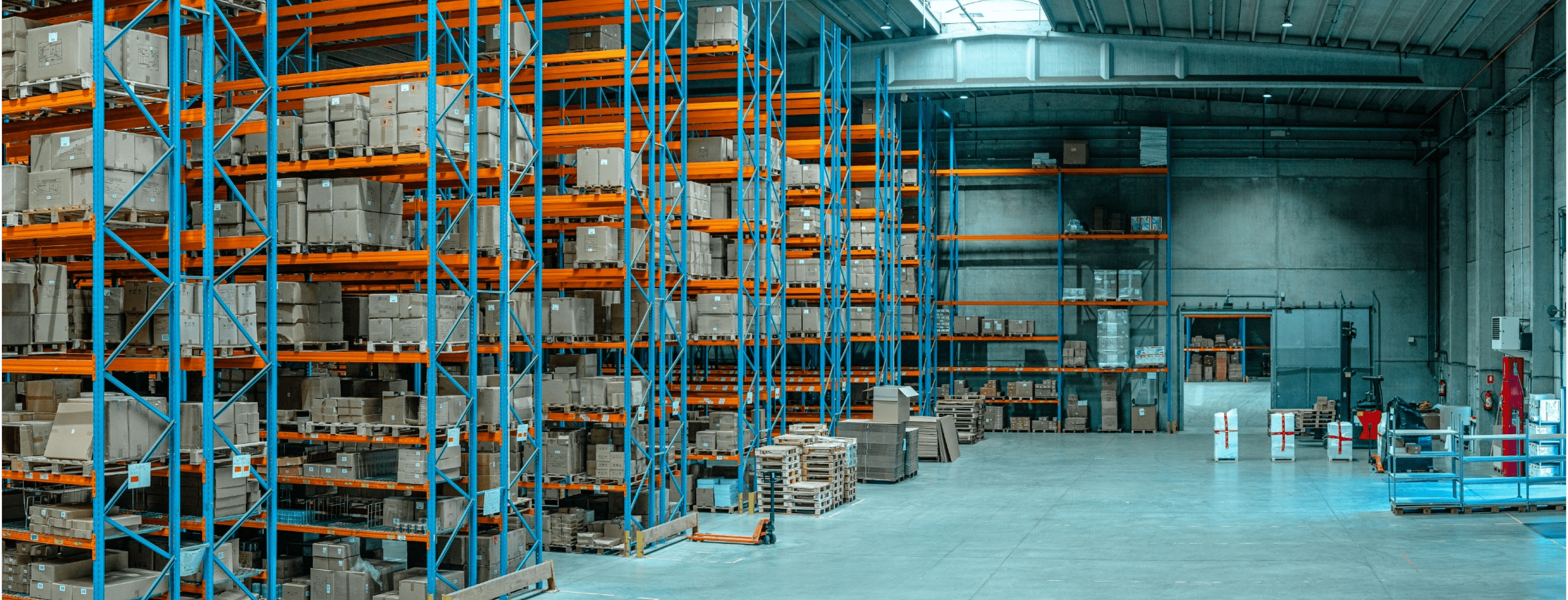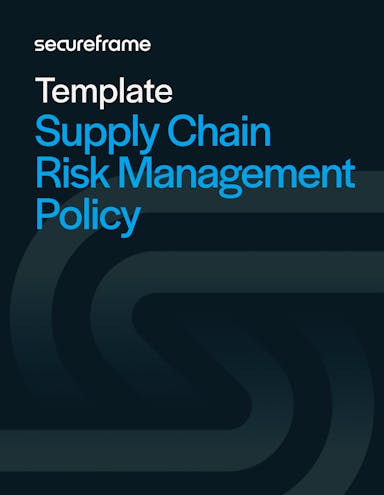
Supply Chain Risk Management (SCRM): A Breakdown of the [Process + Policy Template]
Anna Fitzgerald
Senior Content Marketing Manager
Rob Gutierrez
Senior Cybersecurity and Compliance Manager, CISA, CCSK, CMMC RP
95% of organizations have at least one risk of the three highest rankings of severity within their software supply chain, with the average organization having nine such issues, according to a recent report by OX Security.
Software is just one link in many organizations’ supply chains as well. Since the supply chain poses a significant business risk, it’s essential that organizations have an established process for managing this risk.
We’ll cover what supply chain risk management is, how to set up a process and policy, and what tools can help below.
What is supply chain risk management?
Supply chain risk management is a process companies use to manage supply chain risk. This involves identifying and assessing threats throughout the supply chain — including production, packaging, handling, inventory/storage, transport, mission operation, and disposal — and developing mitigation strategies to protect the integrity, trustworthiness, and authenticity of products and services within that chain.
Supply chain risk management requires a multi-pronged approach to identify, assess, and mitigate risks presented by the supplier, the supplied products or services, and/or the supply chain itself. It also requires managing cyber risks as well as physical ones.
Let’s take a closer look at this subset of global supply chain risk management, known as C-SCRM, below.
What is cyber supply chain risk management?
Organizations that develop or use information, communications, and operational technology (ICT/OT) rely on an increasingly complex, globally distributed, and interconnected ecosystem that involves even more geographically diverse distribution routes, laws, policies, procedures, practices, and assorted technologies.
As a result, organizations must manage the increasing risk of supply chain compromise related to cybersecurity. Examples of cybersecurity risks that can be introduced in the supply chain include products and services that:
- contain malicious functionality
- have unwanted or undocumented functionality
- are counterfeit
- are vulnerable due to poor manufacturing and development practices within the supply chain
Cyber supply chain risk management (C-SCRM) is the process of identifying, assessing, and mitigating the risks associated with the distributed and interconnected nature of ICT/OT product and service supply chains. As with any product or service, supply chain threats and vulnerabilities may intentionally or unintentionally compromise an ICT/OT product or service at any stage so C-SCRM involves managing exposure to cyber risks throughout the entire life cycle of a system. This includes design, development, distribution, deployment, acquisition, maintenance, and destruction.
Cybersecurity risks are just one type of risk that must be managed in supply chains. Let’s look at the types of supply chain risks that exist below.
Recommended reading

Cybersecurity Explained: What It Is & 12 Reasons Cybersecurity is Important
Types of supply chain risks
A supply chain poses risks that could disrupt your company’s operations. Here are some of the top risks to identify and manage below.
Cybersecurity risk
This type of risk involves the susceptibility of a supplier to damage from cyber attacks resulting in loss of data and reputational harm. Cybersecurity risks include ransomware attacks, malware, phishing, denial-of-service attacks, counterfeit file sharing, and even insider threats, to name a few.
Economic risk
A company faces this type of risk by doing business with a supplier that could face economic issues like bankruptcy, a recession, or work stoppage.
Environmental risk
Environmental risk refers to environmental hazards that may affect your supply chain. Natural disasters, extreme weather, port closures, and man-made disasters are all examples.
Reputational risk
Reputational risk refers to the potential damage to the public perception of an organization in the aftermath of an incident like a data breach. An organization takes on reputational risk when working with third-party suppliers. For example, if it’s discovered that one of your suppliers produces significant carbon emissions or waste, then your company’s reputation may suffer as a result.
Operational risk
Operational risk could involve the business interruption of a third-party supplier that disrupts your own organization’s operation or flawed process, procedures or policies. An example is a truck breaking down for one of your suppliers, which could affect the entire supply chain.
Strategic risk
This type of risk refers to changes to technology, personnel, or events that could impact your company’s business strategy or objective. For example, changes to one of your supplier’s operations might not align with your company’s objectives or security requirements.
Compliance risk
Compliance risk comes from a violation of laws, regulations, and internal processes that a company must follow. For example, any business that accepts, handles, stores, transmits, or could impact the security of cardholder data must comply with PCI DSS. Failure to comply with these regulations often comes with a hefty fine, so it’s important that any third-party suppliers you work with are also in compliance.
Compliance risk also comes into play depending on the frameworks your organization pursues. If your organization pursues compliance with NIST 800-53, there’s an entire control family around supply chain risk management. Additionally, many other federal frameworks and commercial frameworks have requirements around third-party vendors and suppliers.
Why is supply chain risk management important? 6 Reasons with Examples
Having a robust process in place to identify and successfully manage supply chain risk is more important than ever as the world becomes more interconnected. Globalization has added complexity to organizations’ supply chains, which means more potential failure points and higher levels of risk. Organizations must manage those risks to maintain their operations, defend critical infrastructure, minimize costs, and protect their reputation, among other reasons.
Let’s take a closer look at these reasons below.
1. Maintaining business continuity
Supply chain attack example: In a Proofpoint and Ponemon survey about the impact of cyber attacks in the healthcare industry, 77% of survey respondents said supply chain attacks disrupted patient care. Patients were primarily impacted by delays in procedures and tests that resulted in poor outcomes such as an increase in the severity of an illness (50%) and a longer length of stay (48%).
Effective risk management enhances a supply chain's ability to withstand and recover from disruptions such as natural disasters, economic crises, supplier failures, miscommunications, geopolitical events, and/or other emergencies. This supply chain resilience minimizes the impact on operations and ensures continuity of supply, which is particularly important in industries like healthcare.
2. Minimizing costs
Supply chain attack example: The NotPetya attack, which affected more than 60 countries, destroyed the computer systems of thousands of multinational companies and caused damages estimated at more than $10 billion.
Proactively managing risks and IT setup can reduce costs associated with supply chain disruptions. This includes lower inventory carrying costs through efficient inventory management practices and minimized losses from unexpected events, like ransomware attacks.
A fundamental concept within supply chain is the idea of being ‘lean’. This includes, but is not limited to, being lean with time, money, and resources. Implementing a lean IT infrastructure and lean IT practices such as least privilege and least functionality can help minimize costs, risks, and waste of resources.
3. Maintaining brand reputation and customer satisfaction
Supply chain attack example: A Waterfall Security report revealed that OT-related attacks impacted over 150 industrial operations in 2022 and caused physical consequences in the real world, including flight delays for tens and thousands of air travelers and malfunctions of cargo containers at half a dozen sea ports on three continents that prevented them from loading and offloading cargoes, among other consequences.
Having a robust supply chain risk management strategy can be a competitive advantage, helping ensure consistent delivery of products and services to customers, thereby preserving trust and satisfaction. By avoiding delays or shortages, companies can uphold their reputation and retain customers.
4. Meeting compliance and regulatory requirements
Supply chain attack example: In 2014, stolen credentials from a third party enabled attackers to enter Home Depot’s network, eventually compromise the point-of-sale (POS) system, and steal more than 50 million credit card numbers and 53 million email addresses over a five-month period. Home Depot paid approximately ~200 million in fines and settlements with customers, card issuers, banks, and states for failing to comply with data security laws and to protect sensitive information. In addition to these payments, Home Depot also had to implement prescribed security requirements, including obtaining a third-party information security assessment.
Many industries are subject to regulatory requirements regarding data security, supply chain operations, safety, and environmental standards. Effective risk management helps ensure compliance with these regulations, avoiding penalties and legal consequences like the ones Home Depot faced.
5. Enhancing decision-making
Supply chain attack example: After the British Library suffered a crippling cyber attack that was likely caused by the compromise of third-party credentials that cost approximately £7 million in recovery costs, the institution issued a report outlining details of the attack and sharing valuable lessons learned. Similar organizations, including knowledge institutions, libraries, and government-funded organizations, can use these lessons to improve their cyber preparedness and mitigation efforts.
By identifying potential risks and their potential impacts, supply chain managers can make informed decisions. This includes strategic sourcing, supplier selection, and business continuity and contingency planning, which are crucial for long-term business success.
6. Protecting national security
Supply chain attack example: During the SolarWinds attack, foreign spies used the company’s updating system to push out malware that allowed them to break into the departments of Commerce, Homeland Security, and the Treasury as well as state agencies including the California Department of State Hospitals and Kent State University and private companies such as Microsoft, Cisco, Intel, and Deloitte. Intelligence officers fear that this attack on the federal software supply chain allowed attackers to not only gain access to sensitive and confidential information but also plant something more destructive for use in the future.
Supply chain risk is also an issue of national importance. When exploited by foreign adversaries, supply chain risks threaten a nation’s critical infrastructure and economic sectors, affecting everything from military operations to emergency response capabilities to healthcare.
Now that we understand the importance of managing supply chain risk, let’s take a closer look at the process below.
Supply chain risk management process
A supply chain risk management process is a series of repeatable steps for identifying, assessing, mitigating, and monitoring risks that can compromise the integrity, trustworthiness, and authenticity of services and products within a supply chain. Having a defined process in place can help your organization minimize the likelihood and magnitude of these risks to the supply chain.
Below is an overview of the steps involved in a supply chain risk management process.

1. Identify and document known risks.
To start, identify potential risks that could affect the supply chain, focusing on known risks. Known risks can be identified, measured, and managed over time. For example, you can estimate the likelihood of a supplier going bankrupt by looking at its financial history and quantifying the impact it would have on your organization. Unknown risks are harder to identify, measure, and manage. For example, you may not be able to predict some natural disasters that affect your supply chain, like the explosion of a long dormant volcano.
A list of potential risks to your supply chain should include natural disasters, geopolitical issues, supplier failures, demand fluctuations, technological disruptions, and regulatory changes, among other risks. These should be documented in one place, often known as a risk register.
2. Assess risks.
Once identified and documented, each risk should be assessed based on its probability and potential impact. This will allow you to identify the products and supply chain nodes with the greatest risk or failure potential and prioritize resources to manage them accordingly.
3. Develop strategies for mitigating risks.
Next, develop strategies to mitigate these identified risks. Examples are diversifying suppliers so you aren’t reliant on a single one, creating redundancy in critical processes, and developing contingency plans if a disaster occurs.
When developing these strategies, consider both their feasibility and cost. These will help determine which risks should be mitigated and which should be accepted, avoided, or responded to in another way.
4. Respond to risks.
Now it’s time to implement your chosen risk mitigation strategies. This might include:
- establishing compliance standards for all third-party suppliers
- finding nearshore suppliers
- conducting internal risk awareness training
- investing in technology to improve supply chain visibility
- creating a disaster recovery plan
5. Continuously monitor and improve.
Supply chain risk management is an ongoing process. You have to continuously monitor your supply chain for changes in risk factors and external conditions and regularly review the effectiveness of your risk mitigation strategies and make changes as needed.
Recommended reading

7 Benefits of Continuous Monitoring & How Automation Can Maximize Impact
Supply chain risk management best practices
Following the best practices below can help minimize threats to your supply chains.
- Create a supply chain risk management policy. A supply chain risk management policy is designed to define and support the protection and controls of supply chain procedures and processes. It should specify roles and responsibilities and what supply chain risk management capabilities will be implemented.
- Create a supply chain risk management plan. A supply chain risk management plan should provide an overview of the security requirements for your company and describe what supply chain cybersecurity controls are already in place or planned for implementation.
- Take a multidisciplinary approach. The most effective supply chain risk management programs distribute responsibilities and accountabilities for risk management activities and risk across a diverse group of stakeholders that includes IT, Security, Legal, and more.
- Map out your supply chain and identify the most critical systems, networks, and information. Map out your supply chain end-to-end, including suppliers, plants, warehouses, and transport routes. Then, identify the most critical systems, networks, and information in your supply chain and prioritize resources to manage risks to those parts of the chain.
- Incorporate supply chain risk management into employee training. For a supply chain risk management program to be successful, every employee in the organization must adhere to best practices. Organization-wide training can help empower senior stakeholders as well as other employees to identify, assess, and mitigate supply chain risks.
- Complete scenario planning and simulation exercises: Simulate various risk scenarios to understand their potential impact on the supply chain and test the effectiveness of your response strategies. This can be an excellent way to identify and fill in gaps in your supply risk management program before a disaster occurs.
- Track and report key metrics. It’s essential to track and report key metrics that measure the performance of your supply chain risk management program against your organization’s risk appetite and tolerance. Risks should also be tracked and regularly reported to executives and/or a risk board.
- Perform supplier risk assessments. A risk assessment is a key part of due diligence. This assessment process is used to identify any potential risks and better understand how data is shared before entering into a legal agreement with a supplier. It can include anything from reviewing supplier’s compliance reports and the attestations of compliance to requesting suppliers to perform a security questionnaire and reviewing results.
- Add security requirements in third-party contracts. In addition to cost, schedule, and performance requirements, add security requirements to your contracts with third parties. These requirements might cover access control, incident response, personnel security, and other areas and should be part of how you evaluate a supplier’s compliance with the contract.
- Use risk management and/or supply chain software. A risk management or supply chain software can help you continuously monitor your infrastructure to detect and remediate any issues as quickly as possible to minimize the impact of an attempted disruption or attack on your supply chain. It can also help you monitor suppliers’ compliance to security and compliance requirements throughout the supply chain lifecycle and simplify supplier risk assessments.
Supply chain risk management policy template
Still unsure of what your supply chain risk management policy should look like? We’ve created a template that you can use as a foundation for building your own.

Download the Supply Chain Risk Management Policy Template
This ready-to-use template helps you establish a structured approach to identifying, assessing, and mitigating risks across your supply chain. Download now to strengthen your security, enhance compliance, and protect your business from disruptions.
Supply chain risk management software
Supply chain risk management software can help reduce the time and effort required to perform supply chain risk management activities, like conducting risk assessments, onboarding suppliers, and continuously monitoring their compliance.
The best supply chain risk management software can help simplify and streamline the following tasks:
- Supplier reviews: Risk management software can allow you to easily store, manage, and review supplier documentation to ensure they’re compliant.
- Supplier risk assessments: Some tools can provide risk recommendations based on the supplier’s assessment information you provide to help simplify the risk assessment process.
- Supplier access tracking: You can easily monitor and track third-party personnel system access using risk management software.
- Supplier Notifications: You should be able to notify suppliers, or be notified by suppliers, in case of any issues or alerts that may affect the supply chain.
- Continuous monitoring: A risk management tool can continuously monitor your suppliers’ security posture and their compliance with regulatory and industry frameworks such as NIST 800-53, FedRAMP, NIST CSF 2.0 and more.
When evaluating supply chain risk management software, look for a solution that offers an easy-to-use platform in addition to a team of security and compliance experts to guide your organization through every step of the supply chain risk management process.
How Secureframe can help companies manage supply chain risk
Secureframe provides tooling for complete third-party risk management (TPRM), simplifying the process of identifying, mitigating, and continuously monitoring risks associated with suppliers as well as vendors, contractors, partners, software providers, open source projects, and other external entities..
Secureframe is able to integrate with dozens of suppliers and vendors you're already using, retrieve their security information on your behalf, and provide a detailed report of their risk profile. Secureframe also allows you to document other details such as owners, types of data, and any due diligence notes from your supplier review as well as attach all relevant documents, such as compliance reports and policies, to the supplier’s profile for easy review.
Automating the repetitive, labor-intensive process of supplier risk assessments can greatly speed up the process for evaluating and onboarding suppliers. Secureframe also simplifies continuous monitoring, enabling you to assign owners to each supplier and schedule annual or one-time reviews to ensure ongoing risk management.
For organizations with more complex third-party ecosystems, Secureframe offers an Advanced TPRM option that includes the following powerful features:
- Comply AI for TPRM: Automatically extract answers from documents like compliance reports, contracts, and policies to save time and reduce the manual effort of security reviews.
- Auto-Detect Shadow Vendors: Identify unauthorized applications and vendors accessed by your employees through Single Sign-On (SSO) to help ensure your vendor list is up-to-date and prevent shadow IT.
- Customizability: Tailor your third-party risk management program with custom scores, tags, departments, and risk assessments.
In addition to these features and functionalities, Secureframe also offers supply chain policies and plan templates that can be customized and distributed for employees to review and accept directly in the platform. Secureframe also supports dozens of frameworks out-of-the-box that includes supply chain controls and tests to help your organization protect itself as you acquire and use technology products and services.
To find out more about how Secureframe can improve your supply chain risk management process, request a demo of our platform today.
FAQs
What are the 6 supply chain risks?
The 6 supply chain risks are:
- Economic risk: Bankruptcy, economic recession, or work stoppage
- Cybersecurity risk: Cyber attack results in loss of data and reputational harm.
- Environmental risk: Natural disasters, extreme weather, port closures, and man-made disasters.
- Reputational risk: Potential damage to public perception in partnering with third-party supplier.
- Operational risk: Flawed processes, procedures, or policies that could result in business disruption.
- Strategic risk: Technology, personnel, or events that could impact your business strategy or objective.
What are the 5 key steps in managing supply chain risk management?
Supply chain risk management involves 5 key steps:
- Identify and document known risks
- Complete a risk assessment to identify likelihood and impact
- Develop a risk mitigation strategy
- Develop a risk treatment plan
- Continuously monitor and improve your supply chain risk management
What does supply chain risk management do?
SCRM is the process of identifying, assessing, and mitigating risks within the supply chain, including risks presented by the supplier, the supplied products and services, or the supply chain. It can help organizations ensure business continuity and resilience in the face of disruptions.
Why is supply chain risk management important?
SCRM is important because today’s global supply chains are complex and interconnected, making them vulnerable to various risks such as natural disasters, geopolitical instability, supplier failures, and cyber attacks. Effective SCRM helps minimize these risks and ensures business continuity.
What are common risks in supply chain management?
Common risks include supplier disruptions, demand fluctuations, transportation delays, quality issues, geopolitical factors (e.g., tariffs, sanctions), natural disasters, financial instability, and cyber threats.
How can supply chain risk management contribute to competitive advantage?
Effective SCRM can enhance supply chain agility, reduce costs associated with disruptions, improve customer satisfaction by ensuring product availability, strengthen supplier relationships, and enhance overall organizational resilience.
What are some challenges in implementing supply chain risk management?
Challenges in implementing SCRM include inadequate data quality and availability, resource constraints (e.g., budget, expertise), and the dynamic nature of risks requiring continuous adaptation of strategies.
Automation can help address these challenges by streamlining data collection and enabling real-time monitoring and analysis across the supply chain. They also facilitate rapid identification and assessment of risks by leveraging advanced analytics and machine learning algorithms to detect patterns and predict potential disruptions. By automating these processes, organizations can enhance their ability to proactively mitigate risks, improve decision-making with timely insights, and strengthen overall supply chain resilience.

Anna Fitzgerald
Senior Content Marketing Manager
Anna Fitzgerald is a digital and product marketing professional with nearly a decade of experience delivering high-quality content across highly regulated and technical industries, including healthcare, web development, and cybersecurity compliance. At Secureframe, she specializes in translating complex regulatory frameworks—such as CMMC, FedRAMP, NIST, and SOC 2—into practical resources that help organizations of all sizes and maturity levels meet evolving compliance requirements and improve their overall risk management strategy.

Rob Gutierrez
Senior Cybersecurity and Compliance Manager, CISA, CCSK, CMMC RP
Rob Gutierrez is an information security leader with nearly a decade of experience in GRC, IT audit, cybersecurity, FedRAMP, cloud, and supply chain assessments. As a former auditor and security consultant, Rob performed and managed CMMC, FedRAMP, FISMA, and other security and regulatory audits. At Secureframe, he’s helped hundreds of customers achieve compliance with federal and commercial frameworks, including NIST 800-171, NIST 800-53, FedRAMP, CMMC, SOC 2, and ISO 27001.